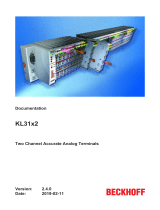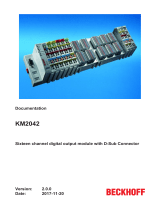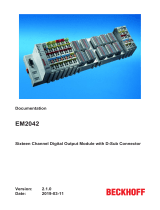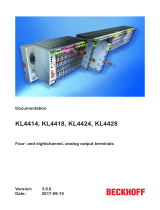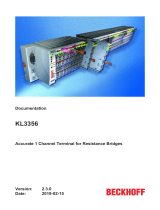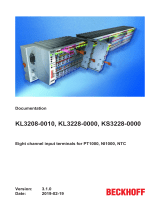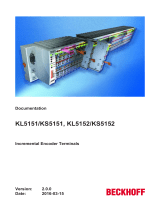Page is loading ...

Documentation
KM4602
Two Channel Analog Output Module with Manual and
Automatic Operation
2.2.0
2019-05-02
Version:
Date:


Table of contents
KM4602 3Version: 2.2.0
Table of contents
1 Foreword ....................................................................................................................................................5
1.1 Notes on the documentation..............................................................................................................5
1.2 Safety instructions .............................................................................................................................6
1.3 Documentation issue status ..............................................................................................................7
2 Product overview.......................................................................................................................................8
2.1 Introduction........................................................................................................................................8
2.2 Technical data ...................................................................................................................................9
3 Mounting and wiring................................................................................................................................10
3.1 Recommended mounting rails.........................................................................................................10
3.2 Mounting and demounting - terminals with front unlocking .............................................................10
3.3 Dimensions......................................................................................................................................12
3.4 Connection ......................................................................................................................................13
4 Access from the user program ..............................................................................................................15
4.1 Process image.................................................................................................................................15
4.2 Mapping...........................................................................................................................................15
4.3 Control and status byte....................................................................................................................17
4.4 Register overview ............................................................................................................................19
4.5 Register description.........................................................................................................................20
4.6 Examples of Register Communication ............................................................................................23
4.6.1 Example 1: reading the firmware version from Register 9............................................... 23
4.6.2 Example 2: Writing to an user register............................................................................. 23
5 Appendix ..................................................................................................................................................27
5.1 Support and Service ........................................................................................................................27

Table of contents
KM46024 Version: 2.2.0

Foreword
KM4602 5Version: 2.2.0
1 Foreword
1.1 Notes on the documentation
Intended audience
This description is only intended for the use of trained specialists in control and automation engineering who
are familiar with the applicable national standards.
It is essential that the documentation and the following notes and explanations are followed when installing
and commissioning these components.
It is the duty of the technical personnel to use the documentation published at the respective time of each
installation and commissioning.
The responsible staff must ensure that the application or use of the products described satisfy all the
requirements for safety, including all the relevant laws, regulations, guidelines and standards.
Disclaimer
The documentation has been prepared with care. The products described are, however, constantly under
development.
We reserve the right to revise and change the documentation at any time and without prior announcement.
No claims for the modification of products that have already been supplied may be made on the basis of the
data, diagrams and descriptions in this documentation.
Trademarks
Beckhoff
®
, TwinCAT
®
, EtherCAT
®
, EtherCATP
®
, SafetyoverEtherCAT
®
, TwinSAFE
®
, XFC
®
and XTS
®
are
registered trademarks of and licensed by Beckhoff Automation GmbH.
Other designations used in this publication may be trademarks whose use by third parties for their own
purposes could violate the rights of the owners.
Patent Pending
The EtherCAT Technology is covered, including but not limited to the following patent applications and
patents: EP1590927, EP1789857, DE102004044764, DE102007017835 with corresponding applications or
registrations in various other countries.
The TwinCAT Technology is covered, including but not limited to the following patent applications and
patents: EP0851348, US6167425 with corresponding applications or registrations in various other countries.
EtherCAT
®
is registered trademark and patented technology, licensed by Beckhoff Automation GmbH,
Germany.
Copyright
© Beckhoff Automation GmbH & Co. KG, Germany.
The reproduction, distribution and utilization of this document as well as the communication of its contents to
others without express authorization are prohibited.
Offenders will be held liable for the payment of damages. All rights reserved in the event of the grant of a
patent, utility model or design.

Foreword
KM46026 Version: 2.2.0
1.2 Safety instructions
Safety regulations
Please note the following safety instructions and explanations!
Product-specific safety instructions can be found on following pages or in the areas mounting, wiring,
commissioning etc.
Exclusion of liability
All the components are supplied in particular hardware and software configurations appropriate for the
application. Modifications to hardware or software configurations other than those described in the
documentation are not permitted, and nullify the liability of Beckhoff Automation GmbH & Co. KG.
Personnel qualification
This description is only intended for trained specialists in control, automation and drive engineering who are
familiar with the applicable national standards.
Description of instructions
In this documentation the following instructions are used.
These instructions must be read carefully and followed without fail!
DANGER
Serious risk of injury!
Failure to follow this safety instruction directly endangers the life and health of persons.
WARNING
Risk of injury!
Failure to follow this safety instruction endangers the life and health of persons.
CAUTION
Personal injuries!
Failure to follow this safety instruction can lead to injuries to persons.
NOTE
Damage to environment/equipment or data loss
Failure to follow this instruction can lead to environmental damage, equipment damage or data loss.
Tip or pointer
This symbol indicates information that contributes to better understanding.

Foreword
KM4602 7Version: 2.2.0
1.3 Documentation issue status
Version Comment
2.2.0 • Update Technical data
• Update structure
2.1.0 • Description of Control Byte corrected
2.0.0 • Migration
1.0.0 • First publication
Firmware and hardware versions
Documentation, version Firmware version Hardware version
2.2.0 1C 03
2.1.0 1C 03
2.0.0 1C 02
1.0.0 1C 01
The firmware and hardware versions (delivery state) can be taken from the serial number printed on the side
of the terminal module.
Syntax of the serial number
Structure of the serial number: WWYYFFHH
WW - week of production (calendar week)
YY - year of production
FF - firmware version
HH - hardware version
Sample with ser. no.: 35 05 00 01:
35 - week of production 35
05 - year of production 2005
00 - firmware version 00
01 - hardware version 01

Product overview
KM46028 Version: 2.2.0
2 Product overview
2.1 Introduction
Fig.1: KM4602
The KM4602 analog output terminal has two potential-free analog outputs (0 to 10V
DC
). Both outputs are
internally connected to a common ground.
For each channel a switch enables selection between automatic and manual mode:
• In automatic mode, an analog value is output as a function of the process data.
• In manual mode, the value set via the potentiometer is applied to the output.
The 24V
DC
(U
L
) Bus Coupler supply voltage is also required for manual mode.
The state of the switches can be read by the controller (bit 0 of the status bytes).

Product overview
KM4602 9Version: 2.2.0
2.2 Technical data
Technical data KM4602-0000
Number of outputs 2
Connection technology Single ended
Output voltage 0 to 10 V
DC
Load > 5kΩ (short-circuit-proof)
Resolution 12 bit
Output error < ±0.1% (based on the end value)
Power supply for the electronics via the K-bus
Current consumption from K-bus typically 175 mA
Width of a bus terminal block Maximum 64 standard Bus Terminals or 80cm
(one KM4602-0000 corresponds to 2 standard Bus
Terminals here)
Data width in the input process image 8 bit status, 16 bit data
Data width in the output process image 8 bit control, 16 bit data
Configuration no address or configuration settings
Operation modes Manual or automatic operating mode
Electrical isolation 500 V (K-Bus/signal voltage)
Dimensions without antenna (W x H x D) approx. 26.5mm x 100mm x 55mm (width aligned:
24mm)
Weight approx. 85 g
Permissible ambient temperature range during
operation
0°C ... + 55°C
Permissible ambient temperature range during
storage
-25°C ... + 85°C
Permissible relative humidity 95%, no condensation
Mounting [}10] on a 35 mm mounting rail [}10] (e.g. DIN rail TH
35-7.5 conforming to EN 60715)
Vibration/shock resistance conforms to EN 60068-2-6 / EN 60068-2-27
EMC immunity/emission conforms to EN61000-6-2/ EN61000-6-4,
EN300-440-02
Protection class IP20
Installation position variable
Approval CE

Mounting and wiring
KM460210 Version: 2.2.0
3 Mounting and wiring
3.1 Recommended mounting rails
Terminal Modules und EtherCAT Modules of KMxxxx and EMxxxx series, same as the terminals of the
EL66xx and EL67xx series can be snapped onto the following recommended mounting rails:
• DIN Rail TH35-7.5 with 1mm material thickness (according to EN60715)
• DIN Rail TH35-15 with 1,5mm material thickness
Pay attention to the material thickness of the DIN Rail
Terminal Modules und EtherCAT Modules of KMxxxx and EMxxxx series, same as the terminals of
the EL66xx and EL67xx seriesdoes not fit to the DIN Rail TH35-15 with 2,2 to 2,5mm material
thickness (according to EN60715)!
3.2 Mounting and demounting - terminals with front
unlocking
The terminal modules are fastened to the assembly surface with the aid of a 35 mm mounting rail (e.g.
mounting rail TH 35-15).
Fixing of mounting rails
The locking mechanism of the terminals and couplers extends to the profile of the mounting rail. At
the installation, the locking mechanism of the components must not come into conflict with the fixing
bolts of the mounting rail. To mount the recommended mounting rails under the terminals and cou-
plers, you should use flat mounting connections (e.g. countersunk screws or blind rivets).
WARNING
Risk of electric shock and damage of device!
Bring the bus terminal system into a safe, powered down state before starting installation, disassembly or
wiring of the Bus Terminals!
Mounting
• Fit the mounting rail to the planned assembly location.
and press (1) the terminal module against the mounting rail until it latches in place on the mounting
rail (2).

Mounting and wiring
KM4602 11Version: 2.2.0
• Attach the cables.
Demounting
• Remove all the cables.
• Lever the unlatching hook back with thumb and forefinger (3). An internal mechanism pulls the two
latching lugs (3a) from the top hat rail back into the terminal module.
• Pull (4) the terminal module away from the mounting surface.
Avoid canting of the module; you should stabilize the module with the other hand, if required.

Mounting and wiring
KM460212 Version: 2.2.0
3.3 Dimensions
Fig.2: KM4602 dimensions

Mounting and wiring
KM4602 13Version: 2.2.0
3.4 Connection
Fig.3: KM4602 connection
Terminal point Description
Channel 1 Signal connection for channel1
Ground Earth connection for channel1
Shield Shield connection for channel1
Channel 2 Signal connection for channel2
Ground Earth connection for channel3
Shield Shield connection for channel2

Mounting and wiring
KM460214 Version: 2.2.0
Internal KM4602 configuration
Fig.4: Internal KM4602 configuration

Access from the user program
KM4602 15Version: 2.2.0
4 Access from the user program
4.1 Process image
The KM4602 terminal module represents itself in the process image with a maximum of 6 bytes of input data
and 6 bytes of output data. These are organized as follows:
Format Input data Output data
Byte
SB1 [}17] CB1 [}17]
Word DataIN1 DataOUT1
Byte SB2 CB2
Word DataIN2 DataOUT2
Legend
SB n: Status byte for channel n
CB n: Control byte for channel n
DataIN n: Input data word channel n
DataOUT n: Output data word channel n
• Please refer to the Mapping [}15] page for the allocation of the bytes and words to the addresses of
the controller.
• The meaning of the control and status bytes is explained in Control and status bytes [}17].
• In process data mode the analog values are transferred in output data words DataOUT1 and
DataOUT4. Input data words DataIN1 and DataIN4 are not used.
Data format
Process data Output voltage
hexadecimal decimal
0x0000 0 0 V
0x3FFF 16383 5 V
0x7FFF 32767 10 V
4.2 Mapping
The Bus Terminals occupy addresses within the process image of the controller. The assignment of the
process data (input and output data) and parameterization data (control and status bytes) to the controller
addresses is called mapping. The type of mapping depends on:
• the fieldbus system used
• the terminal type
• the parameterization of the Bus Coupler (conditions) such as
◦ compact or full evaluation.
◦ Intel or Motorola format.
◦ word alignment switched on or off.
The Bus Couplers (BKxxxx, LCxxxx) and Bus Terminal Controllers (BCxxxx, BXxxxx) are supplied with
certain default settings. The default setting can be changed with the KS2000 configuration software or with a
master configuration software (e.g. TwinCAT System Manager or ComProfibus).
The following tables show the mapping depending on different conditions. For information about the contents
of the individual bytes please refer to the pages Process image and Control and status byte.

Access from the user program
KM460216 Version: 2.2.0
Compact evaluation
With compact evaluation, the analog output terminals only occupy addresses in the output process image.
Control and status bytes cannot be accessed.
Compact evaluation in Intel format
Default mapping for CANopen, CANCAL, DeviceNet, ControlNet, Modbus, RS232 and RS485 coupler
Address Input data Output data
Conditions Word offset High byte Low byte High byte Low byte
Complete evaluation: no
Motorola format: no
Word alignment: any
0 - - Ch1 D1 Ch1 D0
1 - - Ch2 D1 Ch2 D0
Compact evaluation in Motorola format
Default mapping for PROFIBUS and Interbus coupler
Address Input data Output data
Conditions Word offset High byte Low byte High byte Low byte
Complete evaluation: no
Motorola format: yes
Word alignment: any
0 - - Ch1 D0 Ch1 D1
1 - - Ch2 D0 Ch2 D1
Complete evaluation
For complete evaluation, the analog output terminals occupy addresses in the input and output process
image. Control and status bytes can be accessed.
Complete evaluation in Intel format
Address Input data Output data
Conditions Word offset High byte Low byte High byte Low byte
Complete evaluation: yes
Motorola format: no
Word alignment: no
0 Ch1 D0 SB1 Ch1 D0 CB1
1 SB2 Ch1 D1 CB2 Ch1 D1
2 Ch2 D1 Ch2 D0 Ch2 D1 Ch2 D0
Complete evaluation in Motorola format
Address Input data Output data
Conditions Word offset High byte Low byte High byte Low byte
Complete evaluation: yes
Motorola format: yes
Word alignment: no
0 Ch1 D1 SB1 Ch1 D1 CB1
1 SB2 Ch1 D0 CB2 Ch1 D0
2 Ch2 D0 Ch2 D1 Ch2 D0 Ch2 D1
Complete evaluation in Intel format with word alignment
Default mapping for Lightbus, Ethernet and EtherCAT coupler as well as Bus Terminal Controllers (BCxxxx,
BXxxxx)
Address Input data Output data
Conditions Word offset High byte Low byte High byte Low byte
Complete evaluation: yes
Motorola format: no
Word alignment: yes
0 reserved SB1 reserved CB1
1 Ch1 D1 Ch1 D0 Ch1 D1 Ch1 D0
2 reserved SB2 reserved CB2
3 Ch2 D1 Ch2 D0 Ch2 D1 Ch2 D0

Access from the user program
KM4602 17Version: 2.2.0
Complete evaluation in Motorola format with word alignment
Address Input data Output data
Conditions Word offset High byte Low byte High byte Low byte
Complete evaluation: yes
Motorola format: yes
Word alignment: yes
0 reserved SB1 reserved CB1
1 Ch1 D0 Ch1 D1 Ch1 D0 Ch1 D1
2 reserved SB2 reserved CB2
3 Ch2 D0 Ch2 D1 Ch2 D0 Ch2 D1
Legend
Complete evaluation: In addition to the process data, the control and status bytes are also mapped into the
address space.
Motorola format: Motorola or Intel format can be set.
Word alignment: In order for the channel address range to commence at a word boundary, empty bytes are
inserted into the process image as appropriate.
SB n: Status byte for channel n (appears in the input process image).
CB n: Control byte for channel n (appears in the output process image).
Ch n D0: channel n, lower-value data byte
Ch n D1: channel n, higher-value data byte
Reserved: This byte occupies process data memory, although it has no function.
"-": This byte is not assigned or used by the terminal/module.
4.3 Control and status byte
Channel 1
Process data mode
Control byte 1 (for process data mode)
Control byte 1 (CB1) is located in the output image, and is transmitted from the controller to the terminal
module.
Bit CB1.7 CB1.6 CB1.5 CB1.4 CB1.3 CB1.2 CB1.1 CB1.0
Name RegAcces
s
- - - - - - -
Legend
Bit Name Description
CB1.7 RegAccess 0
bin
Register communication off (process data mode)
CB1.6 to CB1.1 - 0
bin
reserved
... ... ... ...
CB1.0 - 0
bin
reserved
Status byte 1 (for process data mode)
Status byte 1 (SB1) is located in the input image and is transmitted from terminal module to the controller.
Bit SB1.7 SB1.6 SB1.5 SB1.4 SB1.3 SB1.2 SB1.1 SB1.0
Name RegAccess - - - - - - OperationMode

Access from the user program
KM460218 Version: 2.2.0
Legend
Bit Name Description
SB1.6 RegAccess 0
bin
Acknowledgement for process data mode
SB1.6 - reserved
... ... ... ...
SB1.1 - 0
bin
reserved
SB1.0 OperationMode 0
bin
Manual mode is enabled for this channel.
1
bin
Automatic mode is enabled for this channel.
Register communication
Control byte 1 (in register communication)
Control byte 1 (CB1) is located in the output image, and is transmitted from the controller to the terminal
module.
Bit CB1.7 CB1.6 CB1.5 CB1.4 CB1.3 CB1.2 CB1.1 CB1.0
Name RegAccess R/W Reg. no.
Legend
Bit Name Description
CB1.7 RegAccess 1
bin
Register communication switched on
CB1.6 R/W 0
bin
Read access
1
bin
Write access
CB1.5 to CB1.0 Reg. no. Register number:
Enter the number of the register [}19] that you
- want to read with input data word DataIn or
- want to write with output data word DataOut.
Status byte 1 (in register communication)
Status byte 1 (SB1) is located in the input image and is transmitted from terminal module to the controller.
Bit SB1.7 SB1.6 SB1.5 SB1.4 SB1.3 SB1.2 SB1.1 SB1.0
Name RegAccess R/W Reg. no.
Legend
Bit Name Description
SB1.7 RegAccess 1
bin
Acknowledgement for register access
SB1.6 R 0
bin
Read access
SB1.5 to SB1.0 Reg. no. Number of the register that was read or written.
Channel 2
The control and status bytes of channel 2 (CB2 and SB2) have the same structure as the control and status
bytes of channel 1 [}17].

Access from the user program
KM4602 19Version: 2.2.0
4.4 Register overview
The following registers are used for parameterization of the KM4602. Each signal channel of the analog
terminal has one register that can be read or written to with the aid of control [}18], status [}18] and data
bytes [}15] via register communication.
Register no. Comment Default value R/W Memory
R0 [}20]
Process data for D/A-C - - R RAM
R1 reserved - - - -
... ... ... ... ... ...
R5 reserved - - - -
R6 [}20]
Diagnostic register (not used) - - R RAM
R7 [}20]
Command register (not used) 0x0000 0
dec
R/W RAM
R8 [}20]
Terminal type 0x11FA 4602
dec
R ROM
R9 [}20]
Firmware version e.g. 0x3141 e.g. 1A
ASCI
R ROM
R10 [}20]
Data length (multiplex shift register) 0x0218 536
dec
R ROM
R11 [}20]
Signal channels 0x0218 536
dec
R ROM
R12 [}20]
Minimum data length 0x9800 38912
dec
R ROM
R13 [}21]
Data structure (data type register) 0x0000 0
dec
R ROM
R14 reserved - - - -
R15 [}21]
Alignment register e.g. 0x7F80 e.g. 32640
dec
R/W RAM
R16 [}21]
Hardware version number e.g. 0x0000 e.g. 0
dec
R/W SEEPROM
R17 [}21]
Hardware compensation: offset (B
a
) 0x0001 1
dec
R/W SEEPROM
R18 [}21]
Hardware compensation: gain (A
a
) typ. 0x0E99 typ. 3737
dec
R/W SEEPROM
R19 [}21]
Manufacturer scaling: Offset (B
h
) 0x0000 0
dec
R/W SEEPROM
R20 [}21]
Manufacturer scaling: Gain (A
h
) typ. 0x0020 typ. 32
dec
R/W SEEPROM
R21 [}21]
Manufacturer's switch-on value 0x0000 0
dec
R/W SEEPROM
R22 reserved - - - -
... ... ... ... ... ...
R30 reserved - - - -
R31 [}22]
Code word register 0x0000 0
dec
R/W RAM
R32 [}22]
Feature register 0x0006 6
dec
R/W SEEPROM
R33 [}22]
User scaling: offset (B
w
) 0x0000 0
dec
R/W SEEPROM
R34 [}22]
User scaling: gain (A
w
) 0x0100 256
dec
R/W SEEPROM
R35 [}23]
User's switch-on value (Y
2
) 0x0000 0
dec
R/W SEEPROM
R36 reserved - - - -
... ... ... ... ... ...
R63 reserved - - - -

Access from the user program
KM460220 Version: 2.2.0
4.5 Register description
The following registers are used for parameterization of the KM4602. Each signal channel of the analog
terminal has one register that can be read or written to with the aid of control [}18], status [}18] and data
bytes [}15] via register communication.
R0: Process data for D/A-C
Process data, which are transferred to the D/A converter.
R6: Diagnostic register
The diagnostics register of the KM4602 is currently not used.
R7: Command register
The command register of the KM4602 is currently not used.
R8: Terminal description
The description of the terminal is contained in register R8.
KM4602: 0x11FA (4602
dec
)
R9: Firmware version
Register R9 contains the ASCII coding of the terminal's firmware version, e.g. 0x3141 (1A
ASCII
). '0x31'
corresponds to the ASCII character '1' and '0x41' to the ASCII character 'A'. This value cannot be changed.
R10: Data length (multiplex shift register)
R10 contains the number of multiplexed shift registers and their length in bits.
R11: Signal channels
Unlike R10, this contains the number of channels that are logically present. Thus for example a shift register
that is physically present can perfectly well consist of several signal channels.
R12: Minimum data length
The particular byte contains the minimum data length for a channel that is to be transferred. If the MSB is
set, the control and status byte is not necessarily required for the terminal function and is not transferred to
the control, if the Bus Coupler is configured accordingly.
/
